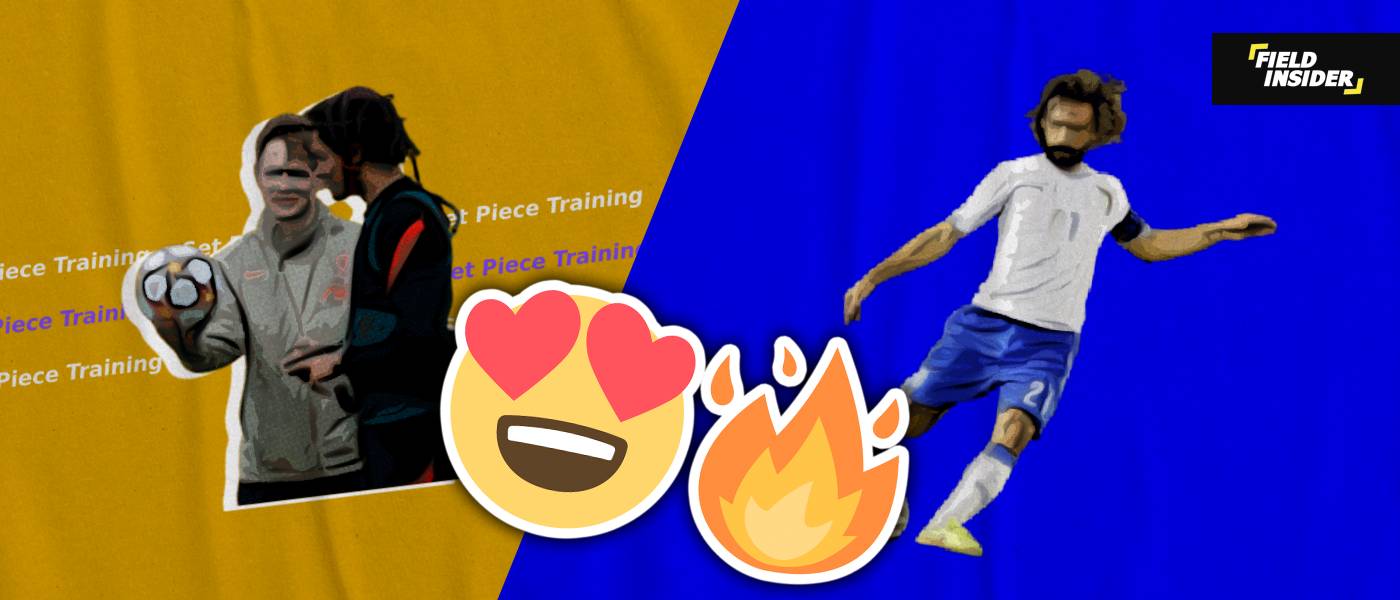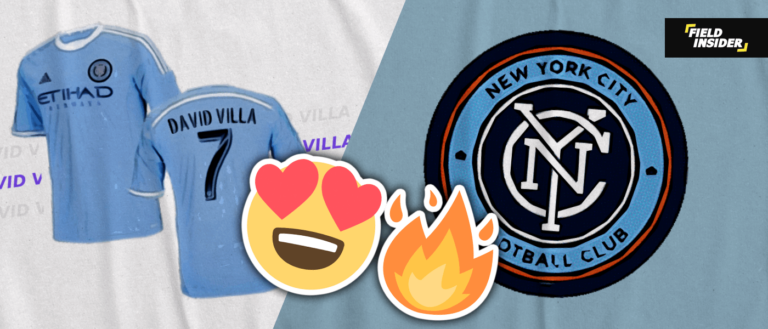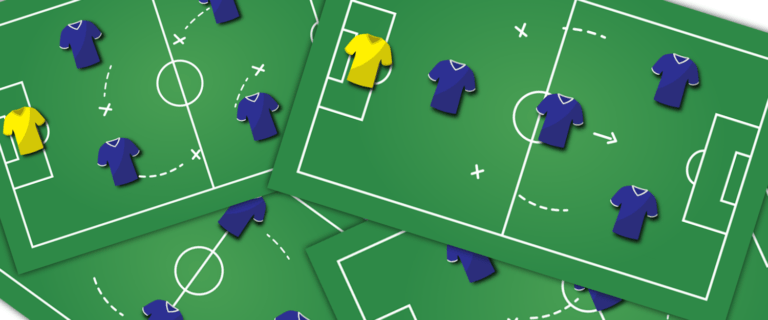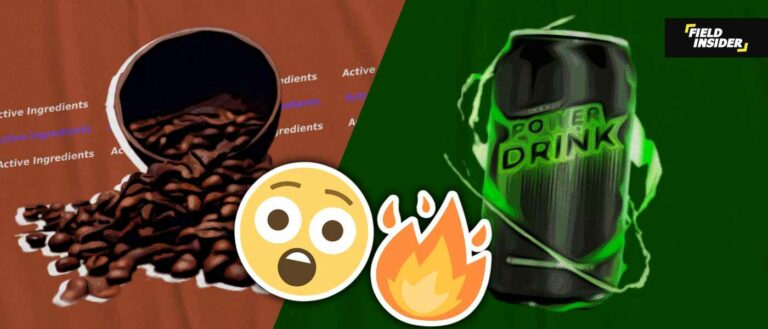Set-Piece Training: Football Essentials
In the fast-paced and strategically complex world of football, set-piece training has emerged as a crucial element for success. Set-pieces, encompassing scenarios like corners, free-kicks, and throw-ins, are moments in the game that can shift momentum, break deadlocks, and often, decide the fate of a match.
This article delves into the essentials of set-piece training, underpinning its importance and effectiveness in modern football.
Key Takeaways
| Aspect | Detail |
|---|---|
| Significance | Set-pieces can decisively influence match outcomes. |
| Basics | Involves planning, execution, and positioning. |
| Professional Insights | Insights from coaches and players emphasize importance. |
| Common Scenarios | Tips for corner kicks, free-kicks, and throw-ins. |
| Training Drills | Drills focus on improving execution and repetition. |
| Evolution | Influenced by technology and data analysis. |
| Expert Opinions | Future trends and continued significance in football. |
The Significance of Set-Piece Training
Why Set-Pieces are Crucial in Modern Football
Set-pieces in football, such as corners and free-kicks, have become increasingly crucial in deciding the outcomes of modern matches. These moments offer unique scoring opportunities, often in high-pressure situations.
They require a blend of individual skill and team strategy, making them a critical focus in football training. Teams that excel in set-pieces gain a significant advantage!
notable set-piece takers in modern football
| Player | Notable For |
|---|---|
| Lionel Messi | Precision and curve in free-kicks |
| Cristiano Ronaldo | Powerful and targeted free-kicks |
| Kevin De Bruyne | Exceptional delivery in free-kicks and corners |
| Trent Alexander-Arnold | Precise and creative set-piece delivery |
| Bruno Fernandes | Scoring and creating opportunities from set-pieces |
| James Ward-Prowse | Free-kick/corner accuracy and consistency |
| Paulo Dybala | Finesse and accuracy in free-kicks |
| Hakan Çalhanoğlu | Proficiency and scoring ability in set-pieces |
| Miralem Pjanić | Technique and control in set-piece execution |
| Dani Parejo | Reliability and effectiveness in set-pieces |
Set-Pieces: Turning Points in Matches
Set-pieces are not just about scoring; they can shift the momentum of a game, break deadlocks, and even demoralize opponents. A well-executed set-piece can be a psychological weapon, instilling confidence in the executing team while putting pressure on the opposition.
In tightly contested matches, mastering set-pieces can be the difference between victory and defeat.
Set-Pieces: Decisive Moments in Football History
Trent Alexander-Arnold’s Quick Corner Against Barcelona (2019)
In the 2019 Champions League semi-final, Liverpool’s Trent Alexander-Arnold executed a quick corner that caught the Barcelona defense unprepared, leading to a crucial goal by Divock Origi.
This moment was pivotal in Liverpool’s incredible comeback and showcased the importance of innovative set-piece tactics.
David Beckham’s Corners in the 1999 UEFA Champions League Final
Manchester United’s stunning comeback in the 1999 Champions League final against Bayern Munich was largely due to David Beckham’s corners in the final minutes.
His precise deliveries resulted in goals by Teddy Sheringham and Ole Gunnar Solskjær, highlighting the impact of well-executed set-pieces in crucial games.
Cristiano Ronaldo’s Free-Kick Against Spain (2018 World Cup)
Cristiano Ronaldo’s remarkable free-kick against Spain in the 2018 World Cup was a showcase of his set-piece prowess.
This goal, completing his hat-trick, secured a draw for Portugal and emphasized the game-changing potential of individual skill in set-piece situations.
Andrea Pirlo’s Panenka Penalty Against England (2012 Euro)
Andrea Pirlo’s ‘Panenka’ penalty against England in the Euro 2012 quarter-finals was a masterclass in psychological and technical execution.
This audacious move shifted the momentum in Italy’s favor, underlining the strategic significance of set-pieces in high-pressure scenarios.
Luka Modric’s Corner Leading to Croatia’s Winning Goal (2018 World Cup Semi-Final)
Luka Modric’s crucial corner in the 2018 World Cup semi-final against England led to Mario Mandzukic’s winning goal in extra time.
This set-piece played a key role in propelling Croatia to their first-ever World Cup final, demonstrating the decisive impact of set-pieces in pivotal match moments.
The Basics of Set-Piece Training
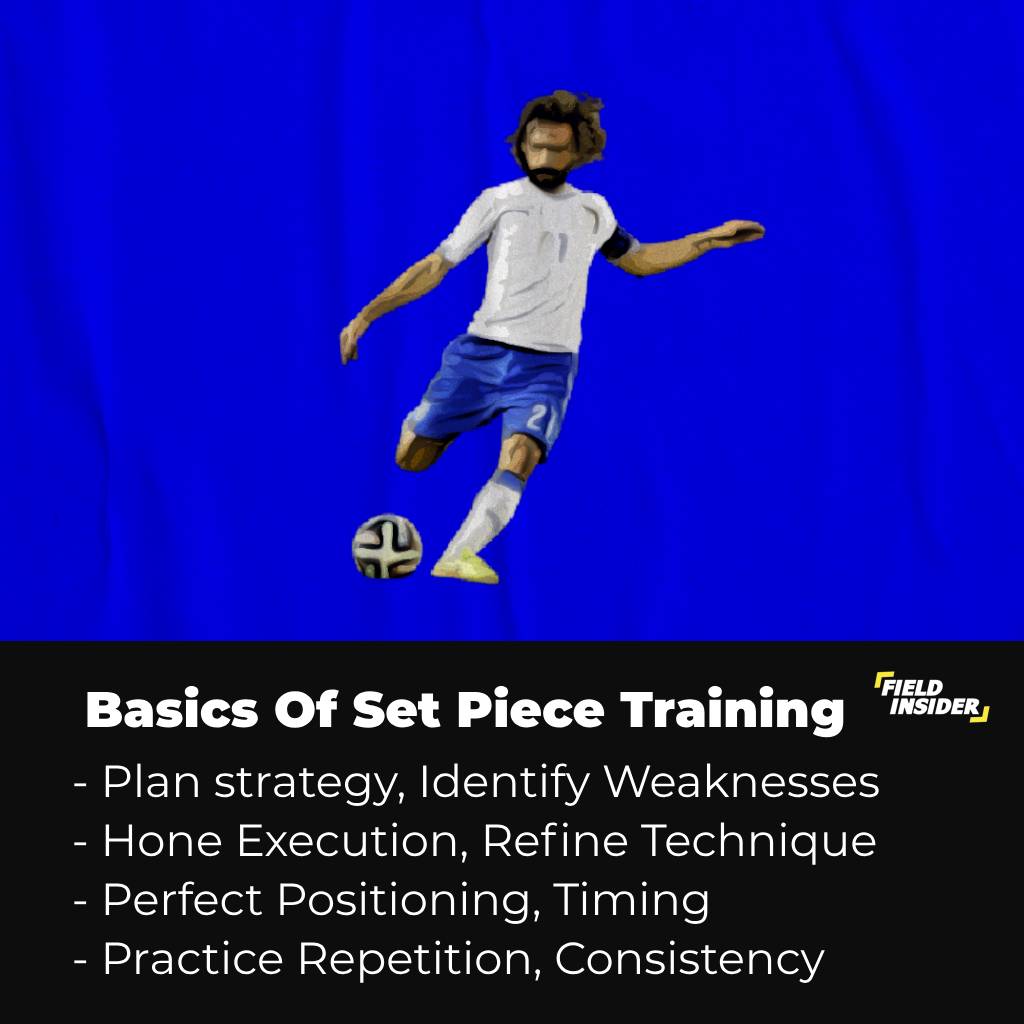
Planning and Strategy
Effective set-piece training begins with meticulous planning and strategy. This involves understanding the team’s strengths and identifying opportunities based on the opponent’s weaknesses.
Coaches play a pivotal role in devising strategies that maximize their team’s chances during set-pieces, taking into account factors like player skills and team formations.
Execution and Technique
The execution of set-pieces is a fine art, requiring precise technique and practice. Whether it’s delivering a swerving free-kick or a well-timed corner kick, players must hone their skills to perfection.
Training for set-pieces often involves repetitive drills, focusing on aspects such as ball delivery, player movement, and rehearsed routines, as seen in practices for attacking formations.
Positioning and Timing
In set-pieces, the positioning and timing of players are crucial. It’s about being in the right place at the right time. This requires players to understand their roles clearly and execute them with precision.
Effective positioning and timing can exploit the opposition’s vulnerabilities, especially during corner kicks and free-kicks, as detailed in set-piece training guides.
Professional Insights into Set-Piece Training
Insights from Renowned Football Coaches and Players
The value of set-pieces is often highlighted by those who have mastered the game – renowned coaches and players. Their experiences and insights shed light on how crucial set-pieces are at the highest levels of football.
Many share tale about critical moments where set-pieces have determined the outcomes of significant matches, emphasizing the need for specialized training and strategy.
“Set pieces can really tie into your philosophy as a coach. It’s interesting in the professional game; you’re starting to see designated set play coaches, and they’re not just covering free kicks and corners, it’s everything.”
James Coutts, Coaching Advisor at PDP
The Role of Set-Piece Specialists in Teams
In the realm of professional football, the role of set-piece specialists cannot be overstated. These are players who have honed their skills to deliver precise and effective set-pieces, becoming invaluable assets to their teams.
Their ability to consistently create scoring opportunities from free-kicks, corners, and other set-pieces can be a game-changer. The presence of a set-piece specialist in a team adds a strategic dimension.
Common Set-Piece Scenarios in Football

Corner Kicks and Their Variations
Corner kicks present unique scoring opportunities in football, and their effective execution can be pivotal in a match. Different variations of corner kicks, such as short corners, in-swinging, or out-swinging deliveries, are used based on the team’s strategy and the opponent’s defensive setup.
Training for corner kicks involves not just the kicker, but also the coordination of movements among the players in the box, aiming to create space and scoring opportunities. Understanding these variations is key, as seen in the strategic deployment in various football formations.
Free-Kicks and Their Placement
Free-kicks are moments in football where individual skill and team strategy converge. The placement of a free-kick – whether it’s aimed directly at goal or used to deliver a cross into the penalty area – depends on the distance, angle, and the wall set up by the opposition.
Training for free-kicks involves mastering ball control, accuracy, and the ability to read the game situation, skills that are crucial in high-pressure scenarios like those in UEFA tournaments.
Throw-Ins and Quick Restarts
Often underestimated, throw-ins can be a tool for maintaining possession or creating attacking opportunities. Quick restarts from throw-ins can catch the opposition off-guard, leading to scoring chances.
Training for throw-ins involves understanding the rules, such as the football throw-in rules, and developing strategies to maximize their effectiveness. Players need to be adept at both delivering and receiving throw-ins, making this an important aspect of set-piece training.
In football, mastering common set-piece scenarios like corner kicks, free-kicks, and throw-ins can significantly impact a team’s performance. These set-pieces require not just individual skill but also coordinated team effort and strategic planning.
Significance of set-pieces
The bar chart graphically represents the percentages of goals scored from set pieces in the FIFA World Cup tournaments for the years 2010, 2014, 2018, and 2022.
Each bar corresponds to one of these years and rises to the percentage value of goals that were scored through set pieces during that particular tournament.
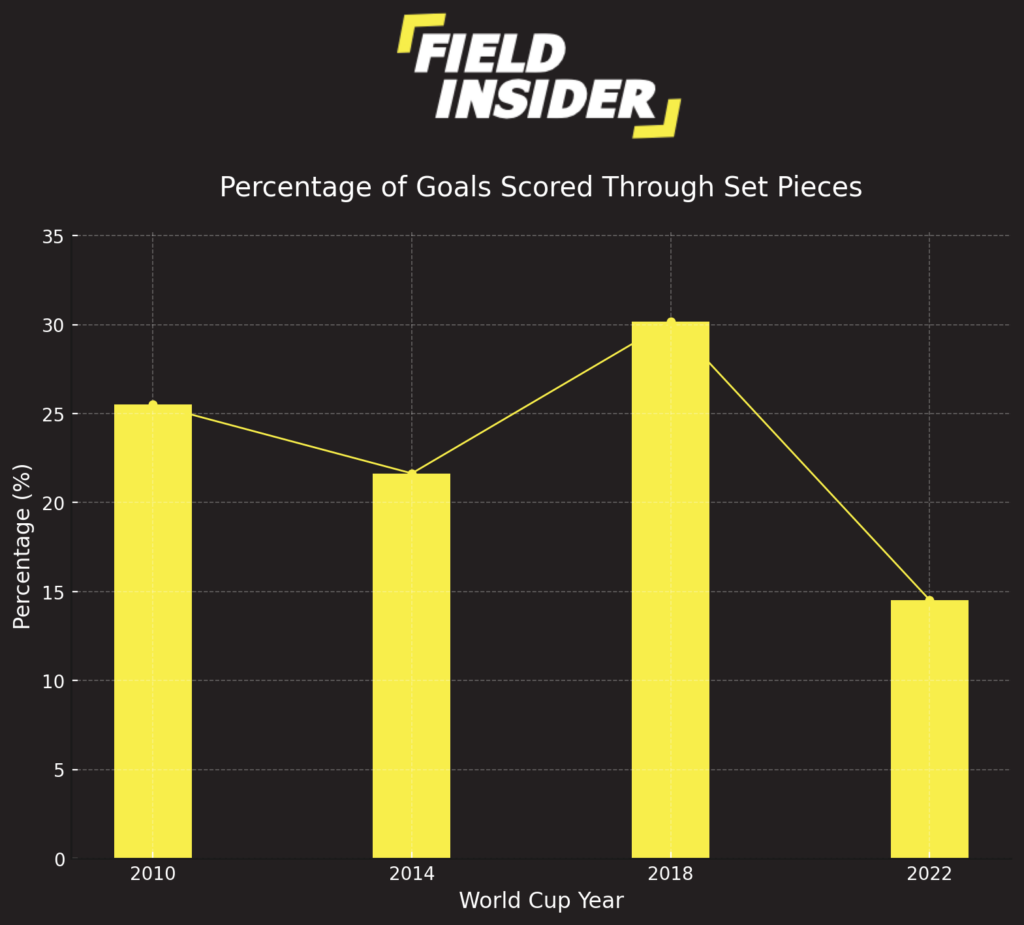
- The bar for the 2010 World Cup reaches just over 25%, indicating that a quarter of the goals were scored from set pieces.
- The bar for the 2014 World Cup is slightly lower, at just under 22%, showing a small decline from the 2010 World Cup.
- The bar for the 2018 World Cup shows a significant increase, exceeding 30%, which suggests a notable rise in the effectiveness or frequency of set pieces.
- The bar for the 2022 World Cup shows a substantial decrease, falling to just over 14%, which is the lowest among the four tournaments displayed.
Approximately , 25% of total goals is scored through set pieces in the world cup which shows the significance of set pieces in the game of football.
Set-Piece Training Drills in Football
Effective Set-Piece Training Drills
The foundation of successful set-piece execution lies in well-structured training drills. These drills are designed to improve various aspects of set-pieces, such as accuracy in delivery, timing of runs, and precision in finishing.
For instance, corner kick drills may focus on the kicker’s delivery and the attacking players’ movements in the box, while free-kick drills emphasize shot accuracy and the creation of effective walls.
Enhancing Football Strategy with Specific Drills
Set-piece training in football is a critical aspect of overall team strategy and involves various specific drills tailored to improve execution and effectiveness. Here are examples of actual training drills that are commonly used to enhance set-piece skills:
Corner Kick Drills
- Near-Post and Far-Post Runs: This drill involves practicing corner kicks aimed at the near post and far post. Players work on timing their runs to meet the ball for headers or volleys. The kicker focuses on delivering the ball with precision to the targeted area.
- Short Corner Variations: In this drill, teams practice short corner routines, where the ball is played to a nearby teammate instead of directly into the box. This involves quick passing and movement to create shooting opportunities from different angles.
Free-Kick Drills
- Wall Bypassing Practice: Players practice free-kicks around or over a defensive wall, focusing on bending or lifting the ball to evade the wall and target specific areas of the goal.
- Set-Piece Shooting Accuracy: This drill involves players taking free-kicks from various positions outside the penalty area, aiming to improve accuracy and consistency in hitting target zones within the goal.
Throw-In Drills
- Quick Throw-In and Movement: Here, players practice taking quick throw-ins to catch the defense off-guard. The emphasis is on the thrower quickly releasing the ball and teammates swiftly moving to advantageous positions.
- Long Throw-In Technique: This drill focuses on improving the distance and accuracy of long throw-ins, which can be used as an alternative to crossing from wide areas, especially near the opponents’ goal area.
Penalty Kick Drills
- Penalty Practice Under Pressure: Regular penalty practice under simulated match conditions helps players improve composure and technique. This often includes practicing different styles of penalties, such as power shots or placement-focused kicks.
- Goalkeeper Penalty Anticipation: Goalkeepers practice reading the penalty taker’s cues and improving their dive timing and direction to enhance their chances of making saves.
These drills are designed to replicate match scenarios, allowing players to develop the necessary skills and understanding for effective set-piece execution.
Improving Different Aspects of Set-Piece Execution
Each set-piece training drill targets specific aspects of execution. For corners, it could be about the flight of the ball and players’ positioning to exploit defensive gaps. Free-kick drills might focus on bending the ball over or around the wall, or on goalkeepers’ positioning and reaction.
Throw-in drills can aim to enhance quick decision-making and precise ball delivery. This targeted approach ensures that each element of a set-piece is perfected, as also seen in the specialized training for ball retention and counter-attacking.
Importance of Repetition and Practice
Repetition is key in set-piece training. Consistent practice helps players internalize their roles and execute them with precision under match pressure.
This repetition not only improves technical skills but also builds a deeper understanding of strategic elements, such as anticipating opponents’ movements and exploiting their weaknesses.
The Evolution of Set-Piece Training in Football
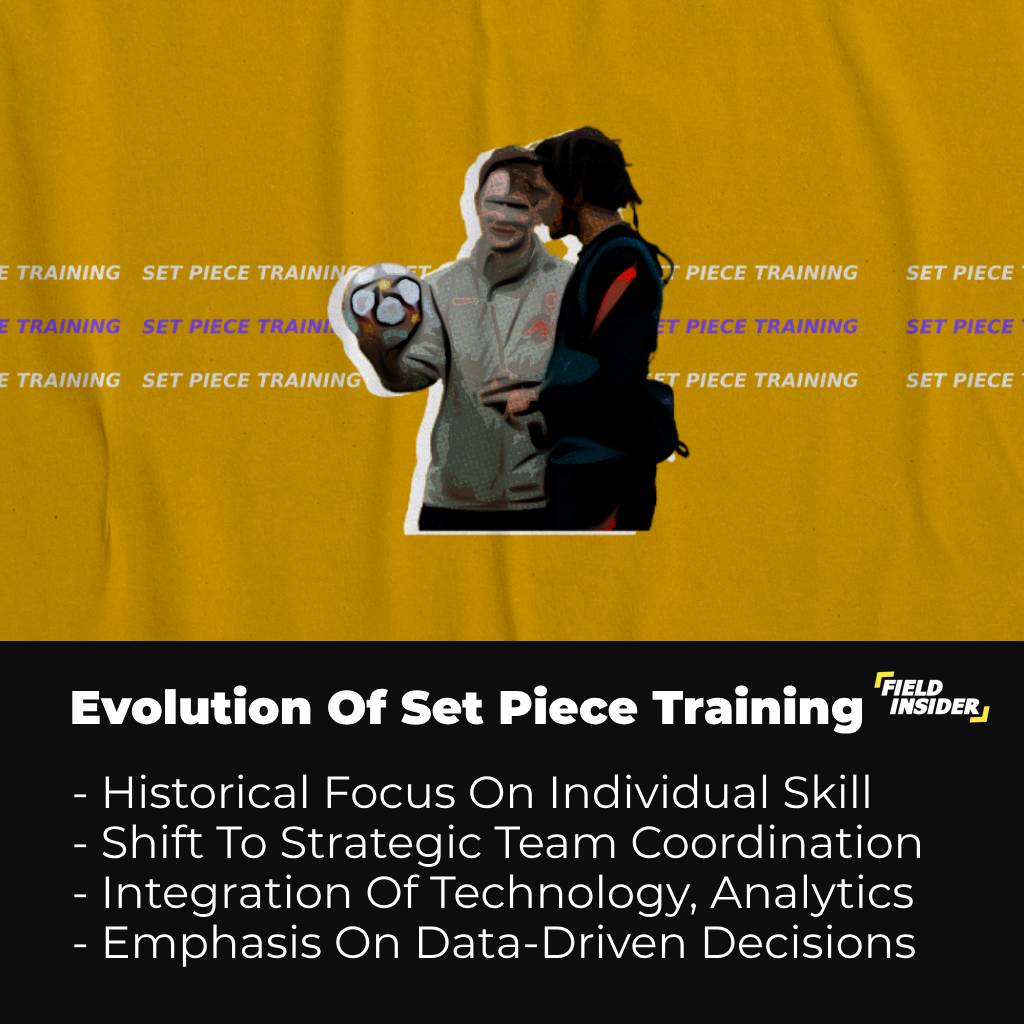
The Historical Development of Set-Piece Training
Set-piece training in football has undergone significant evolution over the years. Historically, set-pieces were often based more on individual skill than team strategy.
However, as football has advanced, the approach to set-piece training has become more sophisticated, emphasizing team coordination, detailed planning, and the utilization of player-specific strengths.
This evolution mirrors the strategic developments seen in various aspects of the game, such as the transition from traditional 4-4-2 formations to more fluid systems like the 4-3-3.
The Impact of Technology and Data Analysis
In recent years, technology and data analysis have significantly impacted set-piece preparation. Teams now use data to strategize their set-piece routines, analyzing opponents’ strengths and weaknesses to optimize their chances of success.
Video analysis, statistical tools, and even virtual reality are employed to simulate scenarios and improve decision-making. This technological advancement in set-piece training is part of a broader trend in football, where data and analytics play a crucial role.
Technology and Data in Set-Piece Analysis
The integration of technology and data in set-piece analysis has revolutionized how teams prepare and execute these crucial aspects of football. Here’s a brief overview of the types of technology and data used:
- Video Analysis Software: Teams use advanced video analysis tools to study set-piece scenarios from previous matches. This software allows coaches to dissect each moment, understand opponent tendencies, and assess the effectiveness of their own set-piece strategies.
- Statistical Analysis Tools: Data-driven tools provide insights into various aspects of set-pieces, such as success rates, player positioning, and the most effective types of delivery (e.g., in-swinging vs. out-swinging corners). These tools help in making informed decisions based on historical data.
- Player Tracking Technology: GPS and motion tracking systems are used during training and matches to analyze player movements. This data is crucial for understanding positioning, timing, and the physical demands of set-pieces.
- Virtual Reality (VR) Training: Some teams are adopting VR to simulate set-piece scenarios. Players can practice in a virtual environment, which helps in understanding spatial awareness and rehearsing specific routines.
- Machine Learning Predictive Models: More advanced teams are employing machine learning algorithms to predict the outcomes of set-pieces based on various factors like player alignment, opponent’s historical responses, and the physical characteristics of set-piece takers.
By leveraging these technological tools and data, teams can gain a significant tactical advantage in set-pieces.
Expert Opinions on Set-Piece Training in Football
There have been several examples where expert opinions have significantly contributed to the understanding and advancement of set-piece training in football. Here are a few notable instances;
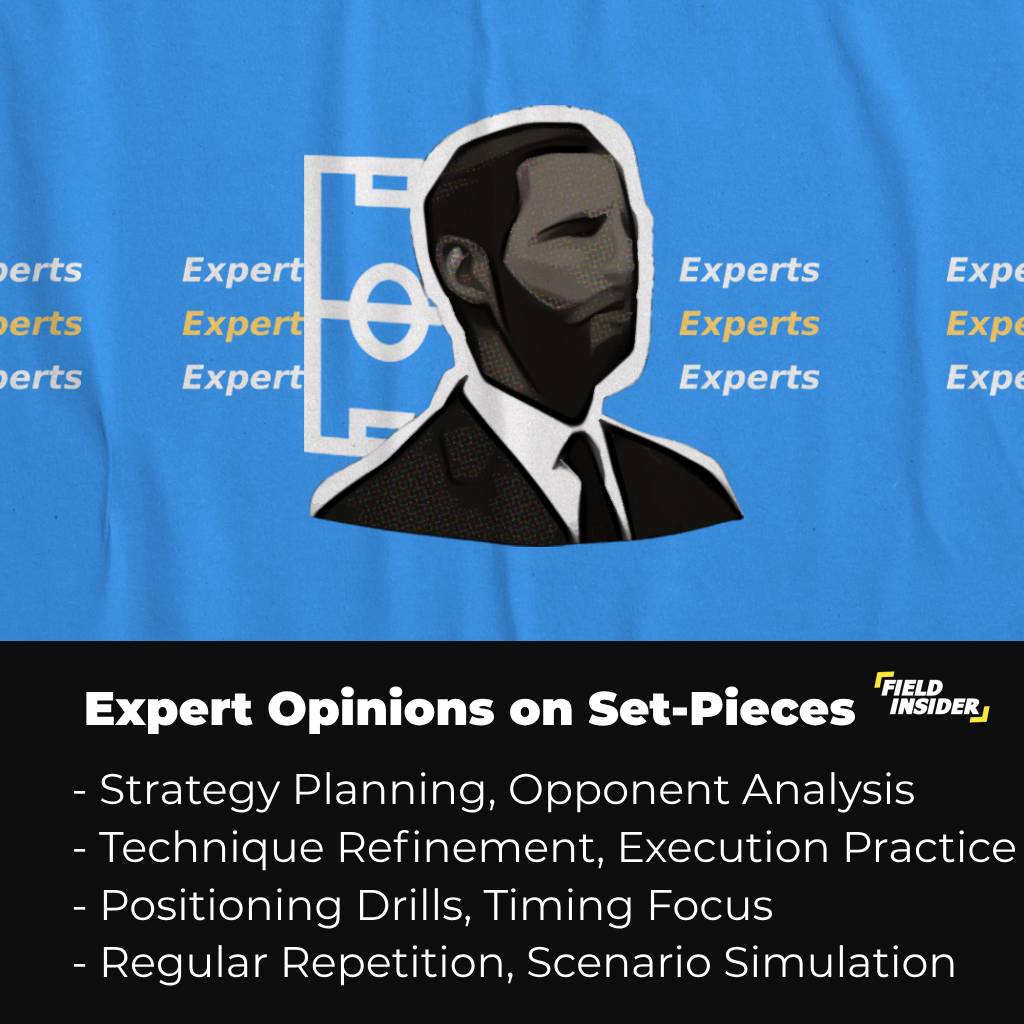
Jurgen Klopp and Liverpool’s Set-Piece Success
Jurgen Klopp, the manager of Liverpool, has brought significant attention to the importance of set-pieces in football. His team’s success, especially in executing corners and free-kicks, is often highlighted in football analyses.
Klopp’s strategy involves detailed planning and innovative training methods, showcasing how effective set-piece tactics can lead to success in top-tier football.
Gareth Southgate and England’s World Cup Tactics
England’s performance in the 2018 World Cup under Gareth Southgate was noteworthy for its effective use of set-pieces. Southgate’s focus on set-piece training, which led to a considerable number of England’s goals.
This has been a subject of discussion among football experts. This approach demonstrated how prioritizing set-pieces in training sessions could yield significant results in major tournaments.
Pep Guardiola’s Approach at Manchester City
Pep Guardiola, renowned for his tactical prowess, has been frequently mentioned by football analysts for his approach to set-pieces at Manchester City.
The team’s offensive and defensive set-piece routines, marked by intricate player movements, reflect Guardiola’s innovative tactics. This approach is often studied and admired for its effectiveness and creativity.
Diego Simeone’s Defensive Mastery at Atletico Madrid
Atletico Madrid under Diego Simeone is often lauded for their defensive strength, particularly in set-piece situations.
Analysts and commentators have highlighted Simeone’s focus on defensive organization during set-pieces, which has made Atletico one of the most formidable teams to score against from these scenarios.
The Impact of Set-Piece Specialists
The influence of set-piece specialists like Lionel Messi, Cristiano Ronaldo, and Kevin De Bruyne is a common topic in football discussions. Experts often analyze how their exceptional skills can alter the dynamics of a game, underscoring the value of having such players on a team.
Technology and Data in Set-Piece Analysis
The increasing role of technology and data in set-piece analysis is a growing topic among football analysts. The use of video analysis to understand opponents’ set-piece strategies and data to determine the most effective set-piece takers reflects the evolving nature of football tactics and training methods.
Conclusion
In conclusion, set-piece training in football is more than just a skill – it’s a strategic element integral to the game’s success.
From the crucial insights of seasoned coaches and players to the innovative use of technology in training, set-pieces have evolved into decisive moments that can change the course of a match.
This article has explored the importance of set-pieces, the nuances of training drills, and the evolving landscape of set-piece strategy, offering valuable insights for anyone passionate about the game.


